What is the most lovable sea mammal in the world? There are so many it is hard to pick, but at the top of the list is the Manatee. I once had the opportunity to swim with a baby manatee in Crystal River, Florida under the guidance of Snorkel with Manatees, a company that provides boating trips to visit these creatures in their natural habitat. From the boat, we could see the air bubbles from the manatee’s nose as it came to the surface to breath. This told us it was time to slip into the water. Once in the water, our group of four tried to be as still as possible by floating on the surface. All of a sudden, as I was peering through my mask, the manatee surfaced in front of me! This baby was as big as us! She was just as curious about us as we were about her! We all hung out with her for a while as she dove up and down and played on the boat ladder! Her mom eventually came back to get her. Words just can describe what an awesome experience this was! 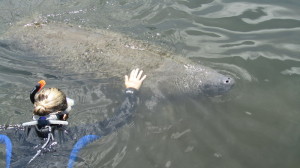
Manatees are very unique and are considered a ‘strange’ species because they belong to a small and unusual group of herbivorous mammals that live underwater- herbivorous aquatic mammals. Evolutionary biologists are interested in manatees because they are an evolutionary link to the more common land-grazing mammals such as the elephant. Scientist can also trace their evolutionary lineage to grass-eating land mammals that lived at least 50 million years ago!
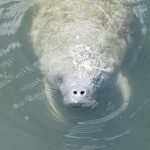 Manatees live in the warm shallow rivers, bays, canals and coastal areas and are also known as ‘sea cows’. They prefer water above 68 degrees Fahrenheit and will rarely be found in water below that temperature. A day in the life of these gentle creatures consists of slowly swimming, eating, and resting. Manatees usually swim at a speed of 5 miles per hour, however they can swim 15 miles per hour in short bursts. Believe it our not, manatees have fingernails and if you could see an x-ray of a front flipper, it looks very much like the bone structure of a human hand.
Manatees live in the warm shallow rivers, bays, canals and coastal areas and are also known as ‘sea cows’. They prefer water above 68 degrees Fahrenheit and will rarely be found in water below that temperature. A day in the life of these gentle creatures consists of slowly swimming, eating, and resting. Manatees usually swim at a speed of 5 miles per hour, however they can swim 15 miles per hour in short bursts. Believe it our not, manatees have fingernails and if you could see an x-ray of a front flipper, it looks very much like the bone structure of a human hand.
As a herbivore, manatees eat water grasses, weeds, and algae. A manatee can eat a tenth of its weight in just 24 hrs. Manatees weigh anywhere from 440 to 1,300 pounds (lbs.) which would translate to eating anywhere from 44 to 130 lbs. of aquatic grasses, weeds, and algae every day! For comparison, do you think you eat a tenth of your body weight in 24 hours? Human beings typically eat 4 lbs. per day on average. If you weighed 70 lbs. that means you would eat 7 lbs. of food! Humans definitely don’t eat as much as manatees!
The Florida Manatee is probably the best known species, but Manatees can also be found in the marshy coastal areas and rivers of the Caribbean Sea, Gulf of Mexico, Amazon Basin, and West Africa. The Amazonian Manatee, unlike some other species of Manatee, never ventures into salt water. In Puerto Rico you can kayak with manatees in Salinas Bay. While kayaking, you mainly see and hear their noses breaking through the water to breath. Once they take a breath, their noses valves that close to keep the water out while underwater. Don’t you wish your nose could do that too?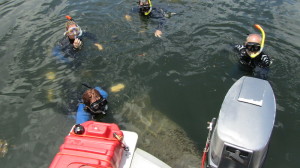
Manatees are classified as endangered animals which means we don’t have many left in the wild and that they are protected by laws to help sustain and increase their population. There are an estimated 2,500 to 3,000 manatees living in Florida waters at this time. Manatees are vulnerable to motor boats and fishing nets. In Florida, there are signs reminding boaters to be on the look-out for manatees as to avoid accidental collisions with this slow moving creatures. Learn more as to how you can help the manatees at the Human Society website and the Save the Manatee Club started by singer Jimmy Buffet and former US Senator Bob Graham. Remember if your wastewater drains to a river…where do rivers go? You got it- they drain into oceans! Using environmentally friendly cleaners and using your drains and toilets for only the intended purposes, are two things you can do that help many aquatic habitats stay healthy including the mantees’!
Look for “Manatee Math” coming to a Science Bug Blog post soon!
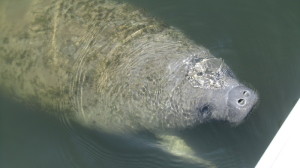
Category: Blog, Mammals, Sea Life, Wildlife
Crystal River Florida, Florida manatees, herbivores, herbivorous aquatic mammals, how fast do manatees swim, how much do manatees weigh, Jimmy Buffet, mammals, manatee, manatees, Salinas, Save manatees, Snorkel with Manatees, things to do in Florida, weight of manatees
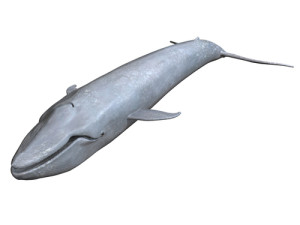
Blue Whale
Blue whales are the largest animals alive today and they have no teeth to eat food! Instead blue whales are filter feeders. There are a total of 15 types of whales that eat this way. These species are known as Baleen whales, because they have baleen plates instead of teeth. These plates are made up of stiff hairs that look like combs and are used to filter food from ocean water. Baleen whales filter small fish, crustaceans known as krill, and plankton from the ocean water. Baleen whales swallow large amounts of ocean water containing the food and then push the water out of their mouths through the baleen. While letting the water out of their mouths, the baleen keeps the food in their mouths. Humpback whales, gray whales, right whales, mink whales, sei whales, Byrde’s whales, and fin whales are all Baleen Whales.
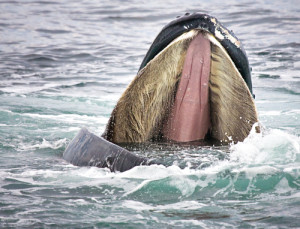
Humpback Whale showing off its baleen inside its mouth!
Scientists in Canada estimated that a Blue Whale can consume 480 million calories of food in a single dive. The average person ONLY consumes 2,000 calories per day. In one day, this whale will consume around 12,500 pounds of food to fuel its 300,000 pound (150 ton) body! Feeding occurs eight months of the year and then these whales live off their bubbler reserves for the other four months. Most of the time they dive to a depth of 300 feet to capture their prey.
Now these numbers don’t mean much unless you compare them to numbers and amounts that are easier to picture! Compared to blue whales an average adult eats about 4.7 pounds of food in one day. Additionally, 2,000 people who each weighed 150 pounds would equal the weight of one blue whale! If 2,000 people are too hard to picture, a blue whale is roughly the weight of 25 African bull elephants!
There are a lot more numbers that can be applied to the blue whale that are just amazing- like their hearts weight roughly 1 ton and are about the size of Science Bug! There are about 12,000 blue whales swimming throughout the oceans today where there used to be around 200,000 to 300,000 whales. Before you go off becoming a blue whale expert, try your hand at the math problems below to see what else you can “figure out” about this amazing animal!

Ariel View of Blue Whale in the Indian Ocean
1. If you round up the amount of food consumed by the average person, how many times more does a Blue Whale eat?
2. What percentage of its body weight does a blue whale eat in one day?
3. How many tons of food does a blue whale eat using the US short ton conversion (1 ton= 2,000 pounds)?
4. Using the numbers above, what is the average weight of a male African elephant weigh?
5. Can you convert the weight of the African elephant from pounds to tons?
6.If a small dog or large cat weighs 15 pounds, how many would you need to equal the weight of the blue whale? African elephant? And the 150-pound person?
7. If the depth that the whale dives to get its food was compared to football field with the 0 yard line (end zone) being at the surface, what yard line would the whale be diving to?
Look for the answers in an up-coming blog post! Send us your answers prior to us posting ours and get your name in the post!
Category: Mammals, Puzzles, Sea Life
baleen, baleen whales, blue whale, blue whale facts, blue whale math, conversions, filter feeder, largest animal, percentages, whales
I never encountered as many toads as I did this summer. I knew they were not frogs because toads have bumps on their skin and most frogs have smooth skin. My cat, Sebastian even found an American Toad under our deck. I immediately thought something was wrong with the toad (see photo below), since it had some brown slime coming from it’s mouth!
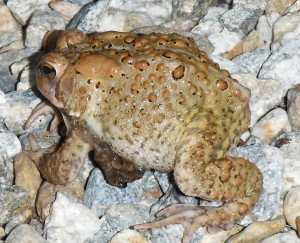
I later learned that toads have the ability to secrete a poisonous slim when they are scared. This toad also puffed itself up to look bigger. This is another part of their defense strategies.
American toads also have special glands, called paratoid glands, which look like bumps on their head. These glands produce a foul-smelling, toxic chemical. This is another defense mechanism that keeps predators from trying to eat it.
Toads start their life in the water and then spend the rest of their lives on land. Toads change from a tadpole to a toad. Some species can do this in only 12 days while others need a full year. When a young toad grows, it’s skin does not grow, so it needs to shed its skin. Ever wonder why no one has brought in a toad skin for show and tell? Toads actually eat their old skin!
Toads also like to bury into the dirt during the hottest parts of the day or for protection. They can dig backwards with their hind legs. Imagine my surprise to dig up this little toad in my flower garden. The dirt was moving and then a Bufo Americanus Toad hopped into the woods. It is very well camouflaged in this picture. Can you find it?
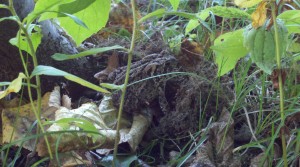
Catch the Science Bug was just at the Chocksett Middle School working with the fifth grade! The students were asked to solve a mystery about natural selection! Everyone made a great effort working on this challenging feat! The following students wrote the best answers:
2014
Zachary and Rowan
Thomas and Aiden
Alex and Dmitri
Adam and Cameih
Jake and Carson
Seth, Noah, and Colman
Natalie and Dylan
Honorable Mention to Maria and Rosie for an awesome picture!
2013
Evan and Owen
Sarah and Anya
John and Caleb
Congratulations on a job well done!

You never know how things might be changing in the woods near your home!
Natural selection could be slowly driving changes right before your own eyes!

What do groundhogs do to get ready for winter?
We usually eat a bit more in the fall since during the winter we will hibernate underground- that means we go into a deep sleep. Sometimes we even dig another burrow for our hibernation. Burrows are usually dug below the frost line (or the depth at which the water in the ground will freeze) so that they will stay warmer. We might go as deep as 5 feet underground when making a burrow. And of course we add a little extra insulation, like grass or hay to keep warm too.
What happens when you hibernate?
Hibernation is kind of like sleeping without getting up until spring. Our body temperature drops and our heart rate, breathing, and metabolism (other chemical reactions in our body) all slow down.
How big is a typical burrow?
In a typical burrow, we might have as many as 5 to 7 openings to the ground surface. Some of my friends have up to 46 feet of tunnels in their burrows. One burrow might require the removal of 35 cubic feet of dirt or 710 pounds of dirt.
What do groundhogs do when out and about all day?
We like to eat. We are herbivores so we only eat plants. Next, we have to watch out for the foxes, coyotes, and hawks that might try to eat us. If we need to we will climb trees to take a look at the surroundings. And believe it or not, we are excellent swimmers.
Do you really look for your shadow on Groundhog Day?
We leave the shadow spotting to the Ground Hogs at the zoos especially to Phil in Punxsutawney, PA. That hole shadow business is too much of a mob scene for us that live in wild. Plus we are still hibernating at that time and really don’t want to leave our warm burrows!
Category: Mammals, Wildlife
animal facts, burrows, frost line, ground hog facts, groundhog, Groundhog Day, herbivore, hibernate, hibernation, PA, Phil, Punxsutawney Phil, science bug blog, shadows

I have always loved penguins, but the more I learned about them, the more I realized how interesting they are from how they can act like a dog when petted, be identified, and what we can all do in our daily lives to help save theirs!
Did you know that most penguins, including these live in warm climates?
Watch the video and learn from the Jason, the biologist who cares for them, what adaptations help them do so!
As a grabbed my cat out of the woods, I couldn’t imagine why this little bird sat only feet away within arms reach. Then it dawned on me, this is only a fledging, or a young blue jay developing into an adult. I put the cat in, got my camera, and luckily I found the fledging again. It could only make short fights from branch to branch. Blue jays leave the nest when they are anywhere from 17 to 21 days old. One of the parents kept a careful eye on me and squawked if I got too close. The family will hang together all summer as the fledgling reaches adulthood. Blue jays not only use the voices to communicate but will also raise the crests on the top of their heads when they feel danger is present. They also are able to mimic the sounds of certain hawks, cats, and humans. Until this little fledgling can fly really well my cats will be staying inside!

Fledgling Blue Jay
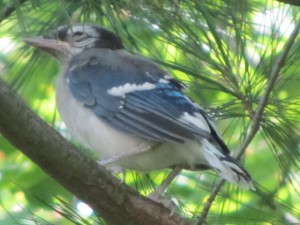
Feathers still growing!

Turn your backyard into a bird observation area that is part of a worldwide network by adding your bird sightings to eBird. eBird is a worldwide database about birds!!! People all over the planet are recording the different types of birds, how many they see, and the date and time that they spotted the bird in their backyards.
By adding your observations you will have your own eBird page which will be a record of what is going on in your backyard. The site says you can add birds that you see on vacation as well. Think about it… a lifetime record of all the birds you ever met! Very cool!
This information helps scientists and conservationist learn more about birds and our environment! You can use allaboutbirds.org to help you identify the birds you see.
I once saw a pileated woodpecker in my backyard, which is a very large bird that to me sounds like a chicken. I honestly thought someone’s chicken had gotten loose was roaming the woods until I got my binoculars out and found the noisy bird pecking in a tree. I haven’t see it since, but if I do, I will let you know on eBird! I will log (submit to eBird) the sighting of the six wild turkeys that came though my yard at dusk yesterday. You just never know what feather friend might show up!

Three of the six wild turkeys
In the beginning of the month of February, I was looking out the window having my morning cup of coffee and this very large bird landed in the woods near my home!

At first I could not tell what type of bird it was and then it few away revealing its idenity. It was a red-tailed hawk. Although far away, you can see the red on the tip of its tail feathers.

It is one of the largest birds in North America but only weighs around 3 pounds. A dog of the same size would weigh around 30 pounds. According to the Cornell Lab of Ornithology hawks prefer to sit by open fields and it was rare that it came into this area. Red-tailed hawks do nest in tree tops. Nests can be as tall as 6 feet and as wide as 3 feet. If you were to measure from the tip of one extended wing to the other that is called the wingspan. The wingspan can be from 3.5 to 4.5 feet across. These big wings help the hawk fly at speeds around 40 miles per hour! Learn more and hear their sound by visiting www.allaboutbirds.org!

 Manatees live in the warm shallow rivers, bays, canals and coastal areas and are also known as ‘sea cows’. They prefer water above 68 degrees Fahrenheit and will rarely be found in water below that temperature. A day in the life of these gentle creatures consists of slowly swimming, eating, and resting. Manatees usually swim at a speed of 5 miles per hour, however they can swim 15 miles per hour in short bursts. Believe it our not, manatees have fingernails and if you could see an x-ray of a front flipper, it looks very much like the bone structure of a human hand.
Manatees live in the warm shallow rivers, bays, canals and coastal areas and are also known as ‘sea cows’. They prefer water above 68 degrees Fahrenheit and will rarely be found in water below that temperature. A day in the life of these gentle creatures consists of slowly swimming, eating, and resting. Manatees usually swim at a speed of 5 miles per hour, however they can swim 15 miles per hour in short bursts. Believe it our not, manatees have fingernails and if you could see an x-ray of a front flipper, it looks very much like the bone structure of a human hand.


























